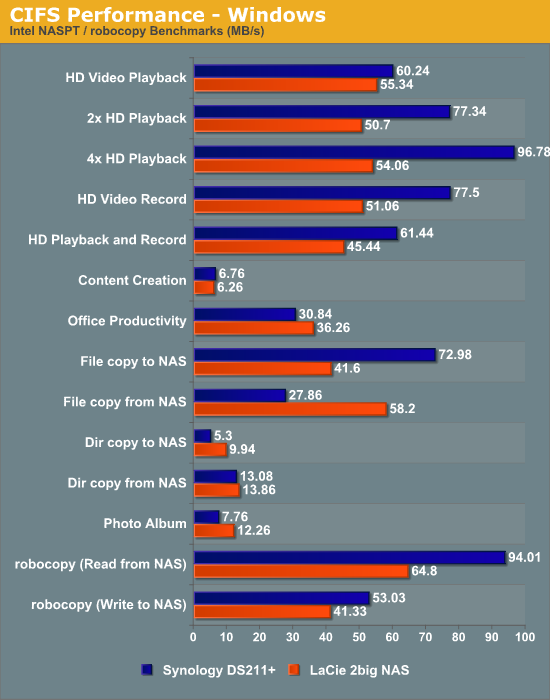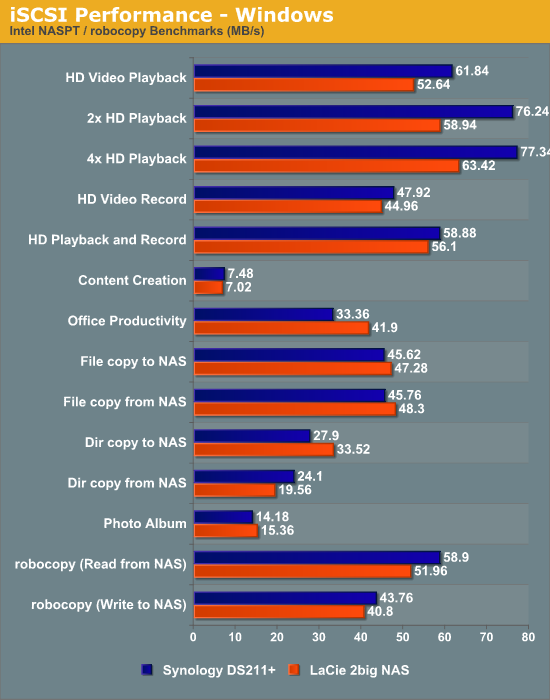LaCie's 2big NAS Review
by Ganesh T S on May 28, 2012 7:55 AM EST- Posted in
- IT Computing
- Storage
- NAS
- LaCie
The performance of the 2big NAS unit was evaluated on the Windows platform using Intel NASPT and our standard robocopy benchmark. As a comparative reference, we also ran the benchmarks using the same disks and under the same circumstances on the Synology DS211+.
The first set of graphs below shows the performance of Samba shares on the LaCie 2big NAS as compared to the Synology DS211+ (updated to the latest DSM 4.0-2228).

We also created a 100 GB iSCSI target and mapped it on the Windows VM. The same benchmarks were run and the results are presented below.

We find that the performance is affected by two factors, namely, the amount of memory in the NAS and the host processor's speed. While the DS211+ scores better in the former category, the LaCie 2big NAS has a 400 MHz advantage in the latter. That said, the DS211+ scores better in more benchmarks (and importantly, in the robocopy benchmark) than the LaCie 2big NAS. This implies that there is lot of scope for improvement in performance in LaCie's NAS OS 2 (and not all of the shortcomings might be due to the lesser amount of DRAM). That said, the 2big NAS is priced lower than the DS211+, so a difference in performance might well be expected.










15 Comments
View All Comments
zzing123 - Monday, May 28, 2012 - link
Apparently a lot of these SOHO NAS's begin to have problems when they fill up, due to both using the inner tracks of the HDD platters, as well as the CPU overhead from software RAID. Rather than benchmarking absolute performance at new, can you begin to see what performance is like with an 85% full drive after a tortuous series of production IO? The reason being is a lot of people are increasingly using these NAS's for iSCSI and this doesn't help matters.See here for more info: http://www.servethehome.com/cost-nas-boxes-perform...
Furthermore, while technologies such as bcache (http://www.phoronix.com/scan.php?page=news_item&am... and BTRFS are nearing kernel inclusion, or even using an OpenIndiana based embedded OS to provide ZFS (like EON), I see very little from the NAS manufacturers that they are even considering these advanced filesystems and SSD tiering, except for Drobo who are wildly overpriced and underperformant.
ganeshts - Monday, May 28, 2012 - link
Thanks for the note. We will keep this in mind for future NAS reviews.In fact, I tried to do something similar to expose QNAP's kernel problem [ http://forum.qnap.com/viewtopic.php?f=189&t=51... ], but left that effort hanging once QNAP owned up to the problem. Maybe it is time to work more on that aspect :)
guste - Monday, May 28, 2012 - link
Ganesh, thanks for the great review. I was wondering if it's possible, next time can you pick colours for the graph that aren't so similar?JarredWalton - Monday, May 28, 2012 - link
How's that?guste - Monday, May 28, 2012 - link
Cheers, Jarred. Thanks kindly.ggathagan - Monday, May 28, 2012 - link
It would be interesting to see if your list of desired features are present on the LaCie "Professional" products that use NAS OS 2.It may be that the focus for their non-"professional" devices is ease of use, as opposed to full features.
I think the review blurb LaCie uses on their web page for the 2big summarizes their target:
“...5/5 – this really is a well made, cool looking NAS that can do pretty much everything you need it to do. My only real problem with it is that I have to give it back!”
Like Apple, LaCie has always focused as much effort on the aesthetics of their products as they have the functionality. Also like Apple, I would expect that mindset to extend to how much of the inner workings of the OS are exposed to the user.
Math nitpick from the unpacking page:
"On the rear side, we have four square slots behind which the fan's exhaust pipe sits"
I see six.
GrizzledYoungMan - Monday, May 28, 2012 - link
Some of my clients are those sorts of people (ie, Lacie customers). And man, it's crazy.They've all suffered a huge identity crisis in the last few years because Apple so clearly doesn't give a shit about its professional users anymore, abandoning FCP and eventually the desktop. Reflexively they want to keep buying Macs because hey, that's what 'creative' people do (never mind that they best pros I've met don't give a shit what type of computer they use). But logically they are running out of reasons to.
I predict mass suicides.
GrizzledYoungMan - Monday, May 28, 2012 - link
I don't know if it's too pricey to make sense for your audience, but you all may want to check out Open-E's DSS V6 NAS software platform.It uses a heavily modified version of FreeBSD (I believe) and runs on a really wide variety of hardware, and provides nearly all of the failover, security and management features of those atomic powered high end enterprise NAS appliances for a fraction of the price (ie, thousands instead of tens of thousands).
I've installed a bunch of these things for clients ranging from SOHO (with heavy storage needs, like video) to SMB all the way up to legit mid-tier enterprise work. They take a bit more knowledge to install than, say, Drobo, but it's the kind of stuff that anyone who works with gray-box appliances routinely will be well versed in.
Coming from things like Windows Storage Server, Drobo, etc the performance is pretty amazing, you really feel like you're getting the most out of the hardware. With basic hardware (a modern low power Xeon mobo, LSI SAS RAID controller populated with 7200 rpm enterprise SATA drives) I routinely see wire speed on transfers from NAS to client machines over gig-e. In the small handful of installations I've done with 10 Gbe present, shit gets crazy.
Most importantly, I've never seen a client lose data thanks to trouble with the software and support from the company is incredible, to the point where they will write unique small patches for specific clients, regardless of size. Between the two, it feels solid like a rock, in a way that many NAS and SAN systems simply don't.
secretmanofagent - Monday, May 28, 2012 - link
I can't help but see the turret. If they make the blue light red, slap an Aperture Science on the side, and they'll get the geeks to swarm over it.sleepeeg3 - Tuesday, May 29, 2012 - link
Probably the last product before they are swallowed by Seagate.